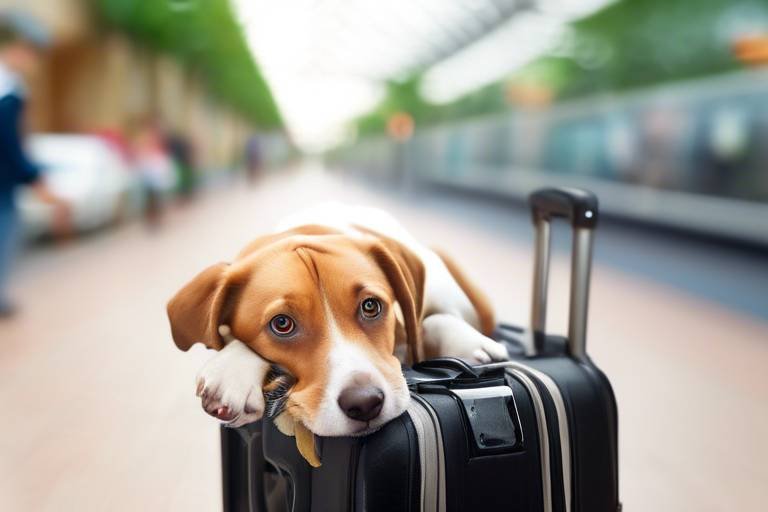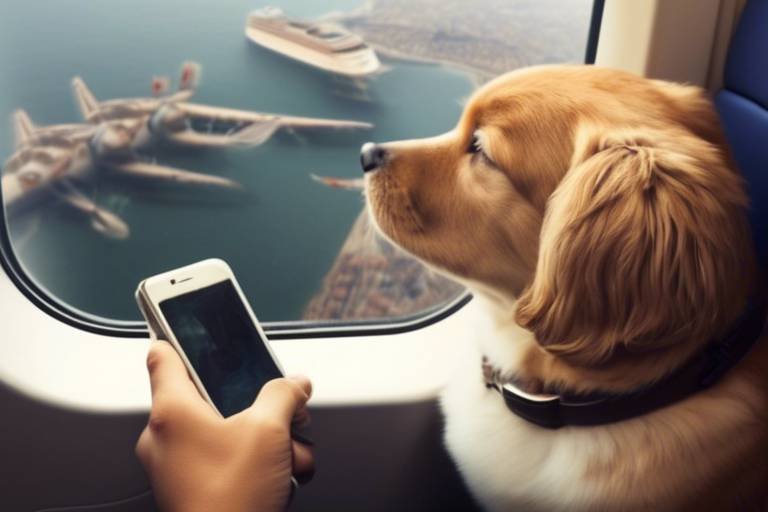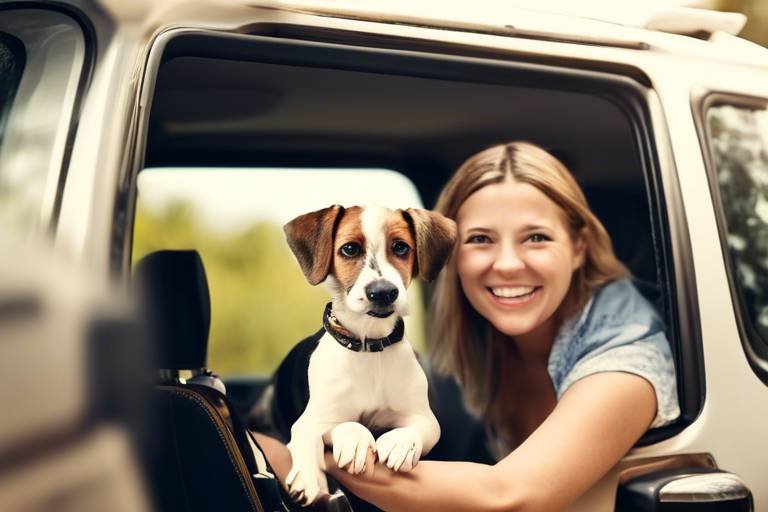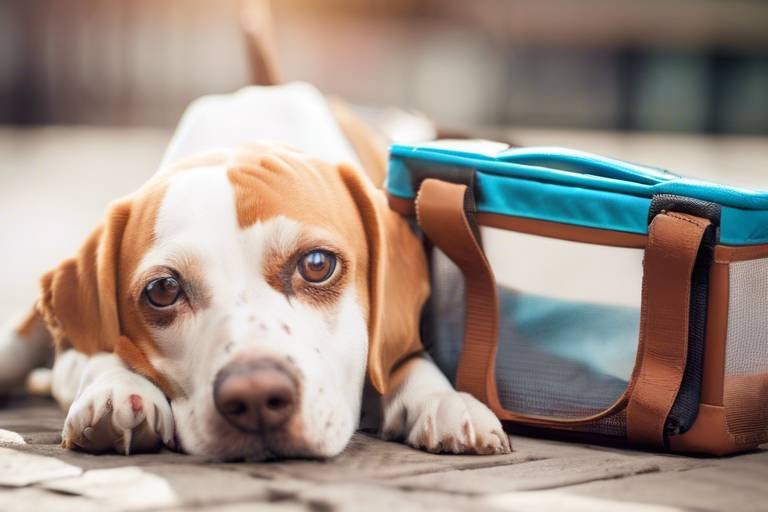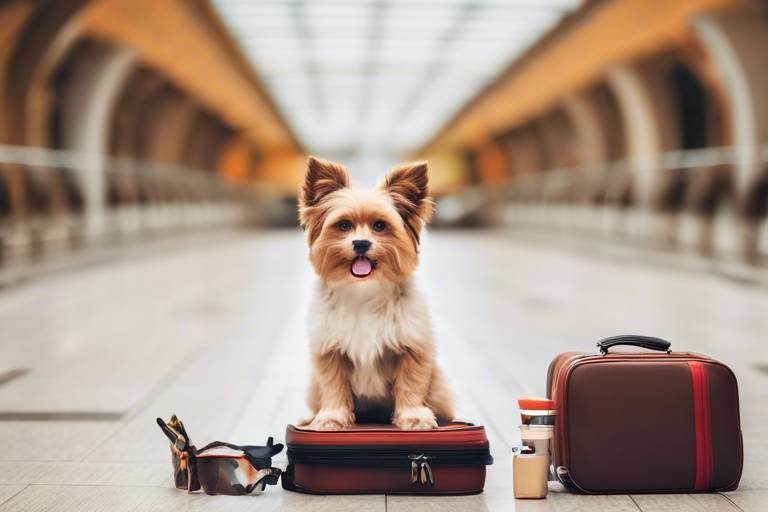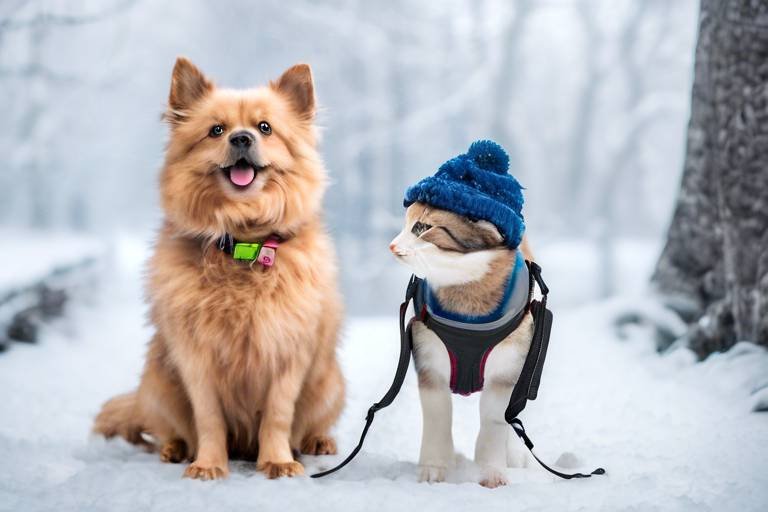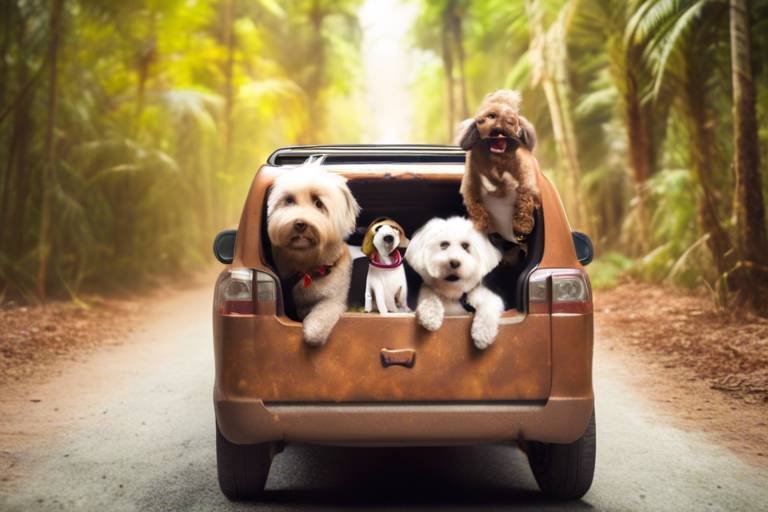Tips for Traveling with Pets in Caravans
Traveling with pets can be an exhilarating experience, especially when you're in the cozy confines of a caravan. Imagine the open road, the wind in your hair, and your furry friend by your side, tail wagging in excitement. However, to ensure that both you and your pet have a safe and enjoyable journey, there are several essential tips to keep in mind. From preparing your pet for travel to selecting the right caravan, each step is vital in creating a memorable adventure. So, buckle up and let’s dive into the world of caravan travel with pets!
Before you even think about hitting the road, it’s crucial to prepare your pet for the journey ahead. This means taking the time to acclimatize them to the caravan environment. Start by letting your pet explore the caravan while it’s stationary. Allow them to sniff around and get comfortable with the new smells and sights. You might find that they love the space just as much as you do! Make sure to bring along their favorite blanket or toy to provide a sense of familiarity. This little touch can make a world of difference in easing any anxiety they might feel.
Selecting the appropriate caravan is a significant step in ensuring your pet's comfort during travel. Not all caravans are created equal, especially when it comes to accommodating our furry friends. Look for features that cater to pets, such as spacious layouts, good ventilation, and easy-to-clean surfaces. Remember, a happy pet makes for a happy journey!
When it comes to space, think about how your pet will move around during the trip. Adequate space is essential for them to stretch out, relax, and feel at ease. Evaluate the caravan layout to ensure your pet has enough room without feeling confined. A cramped space can lead to anxiety and discomfort, which is the last thing you want on your adventure.
The type of flooring in your caravan can significantly impact your pet's comfort. Opt for non-slip, easy-to-clean surfaces that provide a safe and cozy environment. Imagine your furry friend sliding around on a slippery floor—it’s not a pretty picture! Consider materials that can withstand the wear and tear of pet travel while also being gentle on their paws.
Proper ventilation is crucial to keep your pet cool and comfortable during your travels. Make sure your caravan has adequate windows and air conditioning to manage temperature effectively. Remember, pets can’t regulate their body temperature as well as humans, so keeping them cool is vital. A well-ventilated space can prevent overheating and ensure your pet enjoys the journey just as much as you do!
Implementing safety measures is key to protecting your pet during the journey. Utilize harnesses, crates, and barriers to keep your pet secure while on the road. Just like we buckle up for safety, our pets deserve the same level of protection. A sudden stop or sharp turn can be dangerous for an unrestrained pet. So, invest in quality safety gear that keeps them secure and comfortable.
When traveling with pets, planning stops at pet-friendly locations is essential. Research parks, rest areas, and accommodations that welcome pets to ensure a smooth journey. A well-planned route with ample pet-friendly stops allows your furry friend to stretch their legs, relieve themselves, and enjoy the outdoors. After all, a happy pet makes for a happy traveler!
Not all campsites allow pets, so it’s important to research and book pet-friendly options in advance. This ensures a hassle-free experience upon arrival. Imagine pulling up to a campsite only to find out it’s a no-pet zone—what a disappointment! Make a list of potential campsites before you leave, and don’t forget to check their pet policies.
Being prepared for emergencies is crucial when traveling with pets. Carry a pet first aid kit, and know the locations of nearby veterinary services along your route. It’s always better to be safe than sorry! Having a plan in place can give you peace of mind and ensure that your furry friend is taken care of in case of any unforeseen circumstances.
- Can I leave my pet alone in the caravan?
It’s best to avoid leaving your pet alone in the caravan for extended periods, especially in hot weather. - What should I pack for my pet?
Pack their food, water, bowls, leash, waste bags, toys, and a first aid kit. - Are there specific breeds that travel better in caravans?
Generally, smaller and more adaptable breeds tend to travel better, but it ultimately depends on the individual pet's temperament.

Preparing Your Pet for Travel
Traveling with your furry friend can be one of the most rewarding experiences, but it requires careful preparation to ensure a smooth journey. First and foremost, you need to acclimatize your pet to the caravan. This means allowing them to explore the space before the actual trip. Give them time to sniff around and get comfortable with their new surroundings. You might want to consider taking short trips in the caravan prior to your longer journey. This helps your pet associate the caravan with fun adventures rather than just a confined space.
Next, it’s important to ensure that your pet feels secure during the ride. A familiar blanket or toy can provide comfort and make your pet feel more at home. Additionally, you should think about their safety while traveling. Using a pet harness or a secured crate can prevent them from moving around too much, which can be distracting for the driver. Remember, a calm pet leads to a calm journey!
It’s also a good idea to visit your veterinarian before the trip. This ensures your pet is healthy and up-to-date on vaccinations. Discuss any travel concerns you might have; your vet can provide valuable advice tailored to your pet’s specific needs. If your pet tends to get anxious during travel, ask about possible solutions, such as calming treats or medications.
Lastly, don’t forget about hydration and food! Just like humans, pets need to stay hydrated, especially during long trips. Make sure to pack enough food for the journey along with a portable water bowl. Take regular breaks to let your pet stretch their legs and relieve themselves. This not only keeps them comfortable but also gives them a chance to explore and enjoy the scenery!
In summary, preparing your pet for travel involves a mix of acclimatization, safety measures, health checks, and ensuring they have the comforts of home. A little planning goes a long way in making your adventure enjoyable for both you and your furry companion.
- How can I help my pet adjust to the caravan? Start with short trips and allow your pet to explore the caravan at their own pace.
- What should I pack for my pet? Bring food, water, a portable bowl, toys, and a first aid kit.
- Is it safe to let my pet roam freely in the caravan? No, it’s best to use a harness or crate to keep them secure during the drive.
- What should I do if my pet gets anxious while traveling? Consult your vet for calming solutions and take breaks to help them relax.
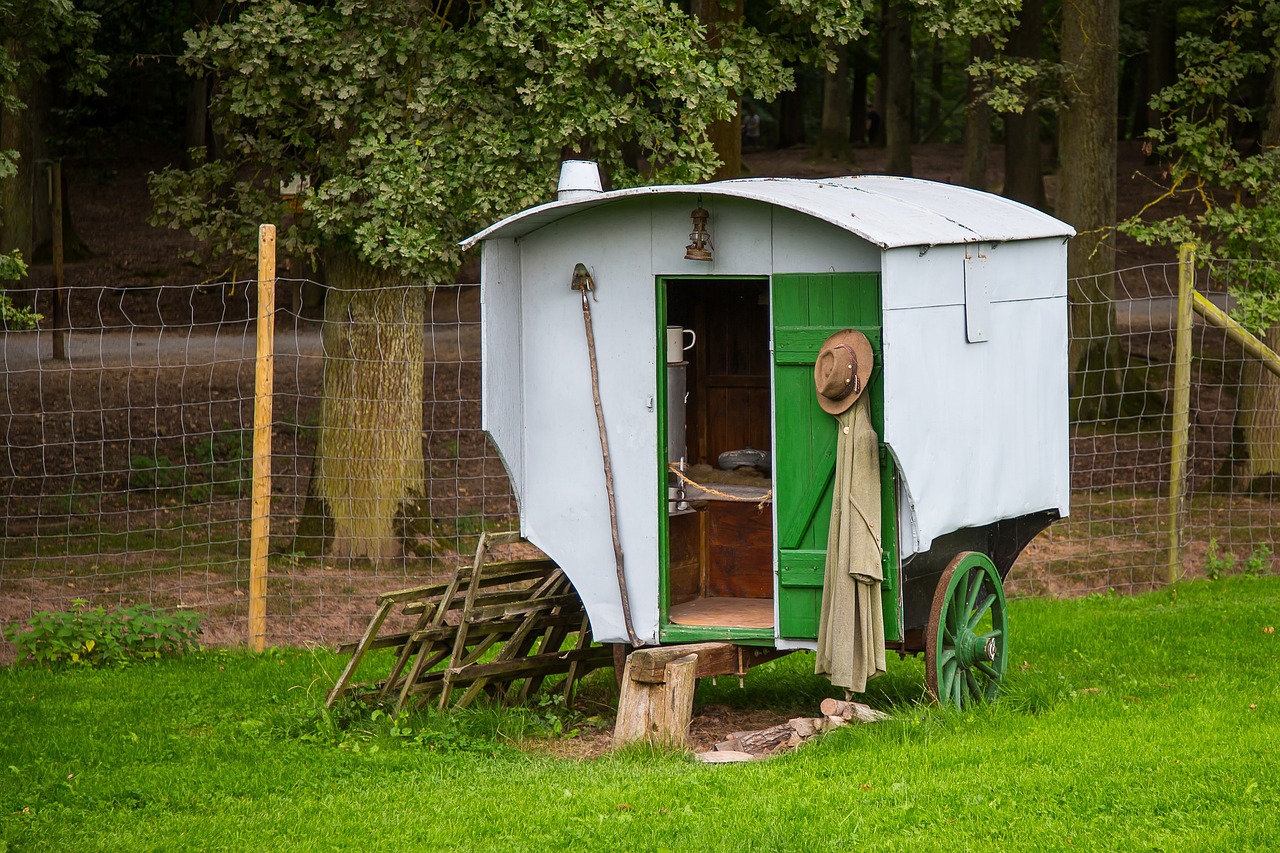
Choosing the Right Caravan
When it comes to traveling with your beloved pets, choosing the right caravan can make all the difference between a delightful adventure and a stressful ordeal. Think of your caravan as a mobile home, and just like you would want a cozy space for yourself, your furry companions deserve the same comfort. The ideal caravan should cater to both your needs and those of your pets. So, what should you look for? Let's dive into the key factors that can significantly enhance your pet's travel experience.
First and foremost, consider the space. Just as we need room to stretch out and relax, pets also thrive in an environment where they can move freely. A cramped space can lead to anxiety and discomfort for your pet, which is the last thing you want during your travels. Look for a caravan with an open layout that allows your pet to comfortably lie down, stand up, and even turn around without feeling restricted. Imagine your pet lying down peacefully while you navigate winding roads—sounds perfect, right?
Next up is ventilation. Good airflow is essential, especially during warm weather. Stuffy, hot caravans can be harmful to your pets. Ensure your caravan has adequate windows that can be opened, as well as air conditioning if you plan on traveling in hotter months. A well-ventilated caravan is like a cool breeze on a hot summer day; it keeps everyone—especially your furry friends—comfortable and happy.
Don't overlook the flooring either. The type of surface can greatly affect your pet's comfort and safety. Opt for non-slip flooring that is easy to clean. Imagine your furry friend sliding around on a slippery surface every time you hit a bump—yikes! A soft, cushioned floor can also provide a cozy spot for your pet to curl up during the ride. Plus, it makes cleaning up any little messes much easier.
Lastly, think about pet-friendly features. Some caravans come equipped with built-in pet beds, feeding stations, and even designated pet areas. These features can simplify your travel experience and ensure that your pet feels right at home. It's like having a mini pet paradise on wheels! If you can find a caravan that offers these extras, you’ll be setting the stage for a fantastic journey together.
In conclusion, choosing the right caravan involves more than just picking a pretty exterior. Pay attention to space, ventilation, flooring, and pet-friendly features. By considering these factors, you’re not just ensuring a comfortable ride for your pets; you're also paving the way for unforgettable memories on the road. So, take your time, do your research, and find a caravan that meets both your needs and those of your furry companions. Happy travels!
- What size caravan is best for traveling with pets? The size depends on the number and size of your pets. Ensure there's enough space for them to move comfortably.
- Are there any specific features I should look for in a pet-friendly caravan? Look for features like easy-to-clean flooring, good ventilation, and designated pet areas.
- How can I keep my pet comfortable during long journeys? Make regular stops, bring their favorite blankets or toys, and ensure they have access to water.
Space Considerations
When it comes to traveling with pets in a caravan, space is not just a luxury; it's a necessity. Imagine yourself cooped up in a tiny room for hours on end—uncomfortable, right? Your furry friends deserve better! Before you embark on your adventure, take a moment to evaluate the layout of your caravan. Is there enough room for your pet to stretch out, roll over, and even play a little? Ensuring that your pet has adequate space can make all the difference in their comfort and happiness during the journey.
It's essential to remember that different pets have different needs. For instance, a large dog will require significantly more space than a small cat. You might want to consider the following factors when assessing the space in your caravan:
- Pet Size: Larger pets will need more room to move around freely, while smaller pets can adapt to tighter spaces.
- Activity Level: An active pet may get restless if confined to a small area for too long, so ensure they have space to roam.
- Rest Areas: Designate a cozy spot for your pet to relax. A soft bed or blanket can create a sense of home, making your pet feel more secure.
Furthermore, consider the layout of the caravan. Does it have designated areas for your pet? A well-planned caravan will have a space where your pet can safely lounge while you navigate the roads. Look for features such as:
- Open Floor Plans: A spacious area allows pets to move around without feeling trapped.
- Separate Sleeping Areas: If possible, create a designated sleeping nook for your pet to retreat to when they want some peace and quiet.
- Storage Solutions: Ensure that you have enough space for pet supplies like food, water, and toys without cluttering their living area.
Ultimately, the goal is to create a harmonious environment that caters to both you and your pet. By investing some time in understanding your pet's space needs, you can ensure a more enjoyable travel experience. Remember, a happy pet means a happy journey!
Q: How can I make my pet feel comfortable in the caravan?
A: To help your pet feel at home, bring along their favorite blanket, toys, and even a piece of your clothing. Familiar scents can provide comfort during travel.
Q: What should I do if my pet gets anxious during the trip?
A: If your pet is prone to anxiety, consider using calming products like anxiety wraps or pheromone sprays. Regular breaks and some playtime can also help ease their nerves.
Q: Are there specific breeds that are better suited for caravan travel?
A: While any pet can travel with the right preparation, breeds that are adaptable and enjoy being in new environments tend to fare better. Consider your pet's personality and energy levels when planning your trip.
Flooring and Comfort
When it comes to traveling with your beloved pet in a caravan, one of the most overlooked aspects is the flooring. The right flooring can make a world of difference in terms of your pet's comfort and safety during the journey. Think of it this way: just as we wouldn’t want to walk on a rough surface barefoot, our furry friends deserve a cozy and safe place to rest their paws. Opting for non-slip flooring is crucial. This helps prevent your pet from sliding around during sudden stops or turns, ensuring they feel secure and stable.
Another factor to consider is the ease of cleaning. Pets can be messy, and accidents can happen, especially during long trips. Therefore, look for materials that are not only comfortable but also easy to clean. Vinyl or laminate flooring can be excellent choices due to their wipeable surfaces. Imagine your pet enjoying a sunny spot on the floor, and you not having to worry about stains or odors lingering for days. Keeping the caravan clean will also contribute to a more pleasant environment for everyone.
Comfort is key, so think about adding rugs or mats in certain areas where your pet likes to lounge. These can provide a soft surface that feels inviting and warm, enhancing your pet's overall experience. Just like we enjoy a plush carpet at home, your pet will appreciate a cozy spot to curl up after a day of adventures. Make sure to choose materials that are pet-friendly and durable, as they will withstand your pet's playful nature.
In summary, the flooring in your caravan plays a vital role in ensuring your pet has a comfortable and safe travel experience. By choosing non-slip, easy-to-clean materials and adding soft surfaces for lounging, you're setting the stage for a delightful journey. Remember, a happy pet means a happy owner, and with the right flooring, you can both enjoy the open road without a hitch!
- What type of flooring is best for a caravan with pets?
Non-slip vinyl or laminate flooring is often recommended as it provides safety and is easy to clean. - How can I make my pet comfortable during long trips?
Adding soft mats or rugs can create a cozy space for your pet to relax. Regular breaks for exercise and bathroom needs are also essential. - Are there any specific pet-friendly materials I should look for?
Look for durable, non-toxic materials that are easy to clean and can withstand wear and tear from your pet.
Ventilation and Temperature Control
This article provides essential tips for a safe and enjoyable journey when traveling with pets in caravans, ensuring both pets and owners have a pleasant experience on the road.
Before hitting the road, it's crucial to prepare your pet for the journey. This includes acclimatizing them to the caravan and ensuring they are comfortable and secure during travel.
Selecting the appropriate caravan is vital for pet travel. Factors such as space, ventilation, and pet-friendly features can significantly enhance the comfort of your furry companions.
Adequate space is essential for pets to move around comfortably. Evaluate the caravan layout to ensure your pet has enough room to relax without feeling confined.
The type of flooring in your caravan can impact your pet's comfort. Opt for non-slip, easy-to-clean surfaces to provide a safe and cozy environment for your furry friend.
Proper ventilation is crucial to keep your pet cool and comfortable during your travels. Imagine being stuck in a small, stuffy room without fresh air; it’s uncomfortable, right? Your pet feels the same way! Ensure that your caravan is equipped with adequate windows that can be opened to allow for airflow. This will not only help in maintaining a pleasant temperature but also keep the air fresh.
Another important aspect is temperature control. During the summer months, the inside of a caravan can heat up quickly, turning it into an oven. To combat this, consider investing in a reliable air conditioning system or fans that can circulate air effectively. If your caravan has a built-in climate control system, familiarize yourself with its settings before you embark on your journey.
Here are some additional tips to enhance ventilation and temperature control:
- Keep windows slightly cracked open while parked to allow air circulation.
- Use reflective window shades to reduce heat buildup inside the caravan.
- Park in shaded areas whenever possible to keep the caravan cooler.
Lastly, always monitor your pet for signs of overheating. Symptoms such as excessive panting, drooling, or lethargy can indicate that your furry friend is struggling with the heat. Remember, keeping your pet comfortable should be a top priority on your travels!
Implementing safety measures is key to protecting your pet during the journey. Utilize harnesses, crates, and barriers to keep your pet secure while on the road.
When traveling with pets, planning stops at pet-friendly locations is essential. Research parks, rest areas, and accommodations that welcome pets to ensure a smooth journey.
Not all campsites allow pets, so it's important to research and book pet-friendly options in advance. This ensures a hassle-free experience upon arrival.
Being prepared for emergencies is crucial when traveling with pets. Carry a pet first aid kit, and know the locations of nearby veterinary services along your route.
Q: How can I keep my pet calm during the ride?
A: Consider bringing their favorite blanket or toy to provide comfort. Taking regular breaks can also help them relieve stress.
Q: What should I pack for my pet?
A: Essentials include food, water, bowls, a leash, waste bags, and any medications your pet may need.
Q: Can I leave my pet alone in the caravan?
A: It's best to avoid leaving your pet alone in the caravan, especially during hot weather, as temperatures can rise quickly.
Pet Safety Measures
When it comes to traveling with your furry companions, are not just optional; they are essential. Imagine cruising down the highway with your beloved pet, only to have them jumping around the caravan, causing distractions. To avoid such chaos, consider implementing several safety strategies that will keep your pet secure and comfortable during the journey.
First and foremost, using a harness or a pet seatbelt is a game changer. Just like we buckle up for safety, our pets deserve the same protection. A harness can be attached to the seatbelt system, allowing your pet to sit or lie down comfortably without the risk of flying forward in case of sudden stops. This not only keeps them safe but also minimizes distractions for the driver.
Another excellent option is to use a pet crate or a carrier. This can serve as a cozy den for your pet, providing them with a sense of security while keeping them contained. Make sure the crate is well-ventilated and has enough space for your pet to turn around and lie down comfortably. Additionally, it’s a good idea to secure the crate to prevent it from sliding around during travel.
Moreover, installing barriers can be beneficial, especially if you have a larger caravan. These barriers can separate the driving area from the living space, ensuring your pet stays in a designated area. This not only helps in keeping them calm but also prevents them from interfering with your driving.
To further enhance safety, remember to keep your pet's essentials within reach. Items like water, food, and their favorite toys should be easily accessible. A pet first aid kit is also a must-have. It should include items like bandages, antiseptic wipes, and any medications your pet may need. Familiarize yourself with the contents of the kit, as knowing how to use it can be crucial in an emergency.
Finally, make sure to take regular breaks during your journey. Stopping every couple of hours allows your pet to stretch their legs, relieve themselves, and hydrate. Look for safe, pet-friendly areas where they can roam around a bit. This not only keeps your pet happy but also helps prevent anxiety and restlessness during long drives.
By taking these , you can ensure a smooth and enjoyable journey for both you and your furry friend. After all, a happy pet means a happy trip!
- How can I keep my pet calm during long travels?
Consider bringing their favorite toys or blankets, which can provide comfort and familiarity during the journey. - Is it safe to let my pet roam freely in the caravan?
No, it’s important to keep your pet secured in a crate or with a harness to prevent distractions while driving. - What should I include in a pet first aid kit?
Your kit should include bandages, antiseptic wipes, tweezers, and any necessary medications your pet may need. - How often should I take breaks during a long trip?
It’s recommended to take a break every 2-3 hours to let your pet stretch, hydrate, and relieve themselves.

Planning Pet-Friendly Stops
When embarking on a caravan adventure with your furry friends, is not just a good idea; it's essential for a smooth and enjoyable journey. Imagine driving for hours without a break—it's exhausting for both you and your pet! Just like humans, pets need to stretch their legs, relieve themselves, and enjoy some fresh air. So, how do you ensure that your travel itinerary is as accommodating for your pet as it is for you?
First, consider the route you'll be taking. Before you hit the road, take some time to research various locations where you can stop. Look for parks, rest areas, and attractions that are known to be pet-friendly. This not only helps in breaking the monotony of the drive but also allows your pet to experience new sights and smells, which can be incredibly stimulating and enjoyable for them. There are several resources available online, including dedicated pet travel websites and apps, that can guide you in finding the best spots along your route.
Another important aspect is to check the rules and regulations of any location you plan to visit. Some parks may have leash laws or specific areas designated for pets. Knowing these details in advance can save you from unexpected surprises and ensure a stress-free stop. For instance, many national parks have specific trails that are pet-friendly, while others may not allow pets at all. Always have a quick look at the guidelines before heading out!
Additionally, consider making a list of pet-friendly accommodations along your route. Not all campsites or hotels welcome pets, so it’s wise to have options ready. You can find a plethora of pet-friendly hotels, motels, and campsites that cater to travelers with pets. Be sure to call ahead and confirm their pet policies, as some places may have restrictions on the size or number of pets allowed. This preparation can make your stops much more enjoyable, as you won't have to scramble for a place to stay last minute.
And let’s not forget about emergency preparedness. When planning your stops, think about nearby veterinary services. It’s wise to know where the closest vet clinics are located in case of any unexpected situations. You can create a small table or a note on your phone with the contact information of vets along your route. This way, you can travel with peace of mind knowing that help is just a phone call away if needed.
Lastly, remember that the journey itself can be just as rewarding as the destination. Take the time to enjoy these stops together with your pet. Whether it’s a quick game of fetch at a park or a leisurely stroll through a pet-friendly beach, these moments can create lasting memories for both of you. So, buckle up, plan wisely, and get ready for an adventure filled with furry fun!
- What should I pack for my pet when traveling in a caravan? Make sure to bring food, water, bowls, a leash, waste bags, a pet first aid kit, and any medications your pet may need.
- Are there specific pet-friendly apps I can use? Yes, apps like BringFido and PetFriendly can help you locate pet-friendly accommodations, parks, and restaurants.
- How can I keep my pet calm during long drives? Regular breaks, familiar toys, and calming music can help soothe your pet during travel.
- What if my pet gets car sick? Consult your veterinarian for advice on how to manage car sickness, which may include medication or gradual acclimatization to car rides.
Finding Pet-Friendly Campsites
When you're on the road with your furry companion, finding pet-friendly campsites can make or break your trip. Imagine pulling into a campsite only to discover that your beloved pet is not welcome—talk about a mood killer! To avoid this scenario, it's essential to do a little homework before you hit the road. First, start by using online resources and apps dedicated to pet-friendly travel. Websites like BringFido and Pets Welcome are treasure troves of information, listing campsites that not only allow pets but also provide amenities to make your stay enjoyable.
When searching for the perfect campsite, consider what your pet needs for a comfortable stay. Look for sites that offer spacious areas for your pet to roam and play. Some campsites even feature dog parks or designated walking trails, which can be a fantastic way for your pet to burn off some energy after a long day of travel. Additionally, it's wise to check if the campsite has any specific rules regarding pets, such as leash requirements or restrictions on certain breeds. This way, you can avoid any unpleasant surprises upon arrival.
Another tip is to read reviews from fellow pet owners. They can provide valuable insights into the campsite's pet policies and overall atmosphere. Look for comments about how welcoming the staff is towards pets, the cleanliness of the facilities, and the availability of pet-friendly amenities like waste disposal stations. You might even find recommendations for nearby attractions that cater to pets, such as hiking trails or pet-friendly beaches.
Also, don't forget to consider the location of the campsite. Proximity to veterinary services can be a lifesaver in case of emergencies. A quick search can reveal nearby animal hospitals or clinics, giving you peace of mind while you enjoy your getaway. Finally, if you have multiple pets or a larger breed, make sure to confirm that the campsite can accommodate your specific needs.
In summary, finding pet-friendly campsites requires a bit of research, but the rewards are well worth it. By planning ahead and ensuring your furry friend is welcome, you can create unforgettable memories together. So grab your leash, pack your bags, and get ready for an adventure that both you and your pet will cherish!
- Are all campsites pet-friendly? No, not all campsites allow pets. It's essential to research and confirm their pet policy before booking.
- What should I bring for my pet when camping? Bring essentials like food, water, a leash, waste bags, a bed or blanket, and any medications your pet may need.
- Can I leave my pet unattended at the campsite? It's generally not advisable to leave pets unattended, as they may become anxious or disturb other campers.
- What if my pet gets sick while camping? Always research nearby veterinary services before your trip and keep a pet first aid kit on hand.
Emergency Preparedness
When it comes to traveling with pets, being prepared for emergencies is not just a good idea; it's a necessity. Imagine you're on a beautiful road trip, the sun is shining, and your furry friend is happily wagging their tail, when suddenly, they experience a health issue. Panic can set in quickly, but with proper planning, you can handle such situations with ease. Start by assembling a comprehensive pet first aid kit. This kit should include essential items such as bandages, antiseptic wipes, tweezers, and any medications your pet may need. Having these items readily available can make a world of difference in an emergency.
Additionally, it’s wise to have the contact information of nearby veterinary services along your route. You never know when you might need a vet, so having a list of veterinary clinics or animal hospitals can save you precious time. You could even create a simple table to keep this information organized:
| Location | Veterinary Clinic Name | Phone Number |
|---|---|---|
| City A | Happy Paws Vet | (123) 456-7890 |
| City B | Compassionate Care Vet | (987) 654-3210 |
| City C | Pet Wellness Center | (555) 123-4567 |
Moreover, consider familiarizing yourself with the signs of common pet emergencies. This knowledge can empower you to act quickly and effectively. For example, knowing how to recognize symptoms of heatstroke, bloat, or allergic reactions can be lifesaving. If your pet shows any of these signs, don't hesitate to seek veterinary help immediately. Remember, the faster you act, the better the chance of a positive outcome.
Lastly, it’s also beneficial to have a plan in place for your pet’s comfort during emergencies. This might include bringing along their favorite blanket or toy, as familiar items can help soothe them in stressful situations. Think of it as creating a little sanctuary for them in the midst of chaos. By being prepared and having a plan, you can ensure that both you and your pet can navigate any bumps in the road with confidence and peace of mind.
Q: What should I include in my pet first aid kit?
A: Your pet first aid kit should include items like bandages, antiseptic wipes, tweezers, scissors, a digital thermometer, and any medications your pet may need.
Q: How can I find pet-friendly veterinary services while traveling?
A: Research veterinary clinics along your route in advance. You can use online resources or apps that specialize in pet care to find nearby services.
Q: What are the signs of a pet emergency?
A: Common signs include excessive panting, vomiting, lethargy, difficulty breathing, or any sudden changes in behavior. If you notice any of these, seek veterinary help immediately.
Q: How can I keep my pet calm during an emergency?
A: Bring familiar items like their favorite blanket or toy to provide comfort. Additionally, practice calming techniques such as gentle petting or speaking to them in a soothing voice.
Frequently Asked Questions
- What should I do to prepare my pet for a caravan trip?
Preparing your pet for a caravan trip is essential for a smooth journey. Start by acclimatizing them to the caravan environment. Spend some time inside the caravan with your pet, allowing them to explore and get comfortable. You can also take them on short trips in the caravan before the big journey to help them adjust.
- How do I choose the right caravan for traveling with pets?
Choosing the right caravan is crucial for both your comfort and your pet's. Look for a caravan that offers ample space for your pet to move around. Ensure it has good ventilation and consider features like non-slip flooring and easy-to-clean surfaces. These factors will greatly enhance your pet's travel experience.
- What safety measures should I implement for my pet during travel?
Safety is paramount when traveling with pets. Always use a harness or a pet crate to secure your pet while on the road. Additionally, consider installing barriers to keep them in a designated area of the caravan. This not only keeps them safe but also minimizes distractions for the driver.
- How can I find pet-friendly stops during our journey?
Planning pet-friendly stops is essential for a stress-free trip. Research parks, rest areas, and accommodations that welcome pets along your route. Websites and apps dedicated to pet-friendly travel can be invaluable resources. Make sure to plan your stops ahead of time to avoid any surprises!
- What should I include in a pet first aid kit for travel?
A well-stocked pet first aid kit is a must when traveling. Include items like bandages, antiseptic wipes, tweezers, and any medications your pet may need. It's also wise to have a copy of your pet's medical records and the contact information for nearby veterinary services along your route.
- Are there specific campsites that allow pets?
Not all campsites are pet-friendly, so it's important to do your homework. Look for campsites that explicitly state they welcome pets. Booking in advance can save you from the hassle of arriving at a site that doesn't allow your furry friend. Always check their specific pet policies too!


